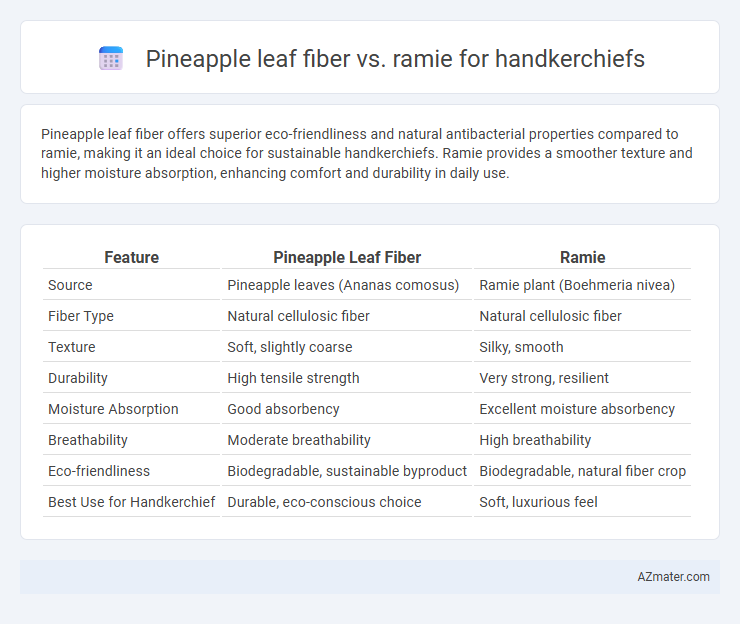Pineapple leaf fiber offers superior eco-friendliness and natural antibacterial properties compared to ramie, making it an ideal choice for sustainable handkerchiefs. Ramie provides a smoother texture and higher moisture absorption, enhancing comfort and durability in daily use.
Table of Comparison
| Feature | Pineapple Leaf Fiber | Ramie |
|---|---|---|
| Source | Pineapple leaves (Ananas comosus) | Ramie plant (Boehmeria nivea) |
| Fiber Type | Natural cellulosic fiber | Natural cellulosic fiber |
| Texture | Soft, slightly coarse | Silky, smooth |
| Durability | High tensile strength | Very strong, resilient |
| Moisture Absorption | Good absorbency | Excellent moisture absorbency |
| Breathability | Moderate breathability | High breathability |
| Eco-friendliness | Biodegradable, sustainable byproduct | Biodegradable, natural fiber crop |
| Best Use for Handkerchief | Durable, eco-conscious choice | Soft, luxurious feel |
Introduction to Natural Fibers for Handkerchiefs
Pineapple leaf fiber and ramie are two natural fibers gaining popularity for handkerchief production due to their sustainability and unique properties. Pineapple leaf fiber offers high tensile strength and a soft texture, making it ideal for durable yet comfortable handkerchiefs. Ramie, known for its silky luster and moisture-wicking abilities, provides a breathable and smooth fabric suitable for sensitive skin and everyday use.
Overview of Pineapple Leaf Fiber
Pineapple leaf fiber, derived from the leaves of the Ananas comosus plant, is a sustainable and eco-friendly material known for its strength, durability, and natural luster. It offers excellent moisture absorption and breathability, making it suitable for handkerchiefs that require softness and comfort. Compared to ramie, pineapple leaf fiber presents a unique texture and biodegradability advantage, appealing to eco-conscious consumers seeking natural textile alternatives.
Overview of Ramie Fiber
Ramie fiber, derived from the stalks of the Chinese nettle plant, is known for its exceptional strength, natural luster, and resistance to bacteria, making it an ideal choice for handkerchiefs. Compared to pineapple leaf fiber, ramie offers superior softness and breathability, enhancing comfort for sensitive skin while maintaining durability through repeated washing. Its ability to absorb dyes well ensures vibrant colors and long-lasting fabric quality in handkerchief production.
Sustainability and Environmental Impact
Pineapple leaf fiber offers a sustainable alternative for handkerchief production, utilizing agricultural waste and requiring minimal water and pesticides compared to conventional fibers. Ramie, a natural cellulose fiber, is highly biodegradable and durable but demands significant water use and chemical retting processes that impact the environment. Choosing pineapple leaf fiber reduces resource consumption and supports eco-friendly textile manufacturing, promoting a lower carbon footprint in handkerchief production.
Fiber Properties: Strength and Durability
Pineapple leaf fiber exhibits high tensile strength and excellent durability, making it resistant to wear and ideal for long-lasting handkerchiefs. Ramie fiber is known for its exceptional strength, even surpassing cotton, and possesses natural lustrous durability that enhances fabric resilience. Both fibers offer robust performance, but pineapple leaf fiber tends to have coarser texture, while ramie provides a softer feel with superior resistance to shrinking and stretching.
Comfort and Skin Friendliness
Pineapple leaf fiber offers a soft texture and excellent breathability, enhancing comfort and making it highly skin-friendly for handkerchief use. Ramie fiber is smooth and lightweight with natural antibacterial properties, providing a cool and hypoallergenic experience ideal for sensitive skin. Both fibers ensure comfort, but pineapple leaf fiber stands out for its eco-friendly production and superior moisture absorption.
Moisture Absorption and Breathability
Pineapple leaf fiber offers superior moisture absorption and breathability compared to ramie, making it an excellent choice for handkerchiefs designed to keep skin dry and comfortable. Its natural structure allows for enhanced airflow and rapid moisture wicking, which helps maintain freshness throughout the day. Ramie fibers, while strong, tend to retain more moisture and provide less ventilation, reducing overall comfort during extended use.
Ease of Processing and Fabric Production
Pineapple leaf fiber offers moderate ease of processing due to its coarse texture, requiring specialized retting and decortication methods to extract fibers suitable for handkerchief fabric production. Ramie fiber, known for its fine, silky texture, processes more smoothly through standard retting and carding techniques, resulting in higher-quality, soft fabrics ideal for handkerchiefs. The fabric production from ramie generally incurs lower processing costs and yields finer, more durable textiles compared to the relatively rougher pineapple leaf fiber.
Aesthetic Qualities: Texture and Appearance
Pineapple leaf fiber offers a unique coarse texture with natural luster that enhances the rustic, organic aesthetic of handkerchiefs, providing a distinctive, eco-friendly appeal. Ramie fiber features a silky, smooth texture and glossy finish, yielding handkerchiefs with a refined, elegant appearance and excellent drape. Both fibers present visually appealing options, with pineapple leaf fiber emphasizing durability and earthiness, while ramie excels in softness and sophistication.
Cost and Market Availability
Pineapple leaf fiber offers a lower-cost alternative to ramie, making it more accessible for budget-conscious handkerchief manufacturers. Ramie, while generally more expensive, is valued for its high tensile strength and smooth texture, which appeals to premium markets. Market availability of pineapple leaf fiber is increasing due to its sustainability and byproduct status from pineapple farming, whereas ramie supply depends on specialized cultivation, limiting its regional availability.

Infographic: Pineapple leaf fiber vs Ramie for Handkerchief
 azmater.com
azmater.com